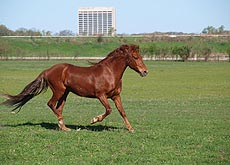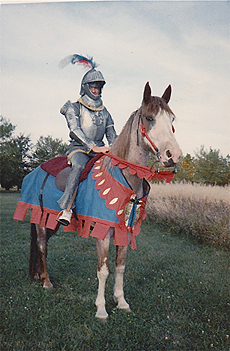Goodbye, Indian Creek Riding Club
 |
Former Indian Creek Riding Club member Barbara Oddone kept Ru, a Peruvian Paso gelding, at the Indian Creek Stables. Photo: Terry Tope, PPD |
In 1970, Sandra Rumple, a National Accelerator Laboratory employee, began a memo to founding director Robert Wilson by recounting a vision she'd had. In her vision, NAL had won the Kentucky Derby thanks to a horse named Anti-Matter.
"He had received hundreds of hours of training and devotion on the 6,800 acres of the NAL site as well as good feed and care," wrote Rumple of her dream.
Her playful sketch introduced one of several more serious proposals from employees for a boarding stable and riding club for NAL employees. In 1971, after some back-and-forth with the director, the employees got their wish: The Indian Creek Stables and Indian Creek Riding Club became an official part of the recreational life of the laboratory.
Next fall, in October 2016, the riding club and stables at Fermilab will close, but their 45 years at the laboratory will leave an important legacy, a reminder that Robert Wilson's vision of Fermilab as a pioneering laboratory extended to the vast prairie land on which it is built.
"When I'd tell people I worked at Fermilab, I'd also mention that I have my horse here, and they would ask, 'What? What do you mean?'" said Technical Division's Marsha Schmidt. Schmidt's quarter horse, Style, boards at the Indian Creek Stables, which is where Schmidt also kept her first horse, Biddy, in 1980. "I'd relate the story of how Wilson wanted to start it, adding to the beauty of the site. It's been a huge part of my life."
In appealing to Wilson in 1970, Rumple connected Fermilab's natural beauty with the establishment of a home for horses on laboratory grounds. She claimed they would be a productive addition to the facilities, lending a "rural elegance" to the grounds.
And so they have. Over the years, the horses have provided people with a way to enjoy the prairie paths and a rare, enjoyable mental and physical activity.
"It's a cathartic release for me to take the horse and be out on the prairie," said Target Systems Department's Chris Kelly, who owns a roan named Honey and has been an ICRC member for more than 20 years. "It's an indescribable feeling to see the 6,800 acres that way — the beauty of the different seasons, riding on a snowy night. I'm not a fast car guy, but I do like to go fast. Seeing things on horseback is my idea of speed."
Until earlier this year, the Indian Creek Stables, situated on Site 56 near DZero, were always at or near capacity — 17 horses. ICRC members pay dues to cover the cost of horse care, stable maintenance and trail upkeep.
"I had never owned a horse before Ru arrived at Fermilab," wrote recent ICRC member Barbara Oddone in an email. "I have sweet memories of the pleasure of riding at the forest preserves and around Fermilab, especially in spring and summer under the immense sky and surrounded by so much bird and wildlife activity."
The owners of the five horses currently living in the Indian Creek Stables are looking for new homes to board the horses.
"Equestrianism has been a special part of our lab's history," said Fermilab COO Tim Meyer. "Just as Fermilab is going through a transformation from the Tevatron to LBNF/DUNE for its second 50 years, so too the campus and community are evolving in the face of new constraints and new opportunities."
The opportunity to keep horses on site has led not only to strong bonds between ICRC members and their animals, but also to lasting relationships with other people by sharing their passion for riding.
"We've always been open to employees and visitors to come out and experience what it's like to ride a horse," Kelly said. "The relationships I've made that way are still strong — with people all over the world. The way they appreciate the horses — it's universal."
Even after they leave, the horses at Fermilab will be remembered for their companionship, the perspective of the prairie they offered, and the rural elegance they added to the Fermilab site.
—Leah Hesla
 |
Horses have been a notable part of Fermilab's history. On Sept. 19, 1986, as part of a labwide party, then-director Leon Lederman inspired fellow physicists on the noble quest for knowledge by donning a knight's suit of armor and ascending the stairs in front of Wilson Hall on his horse Cody. Photo courtesy of Ellen Lederman |
|